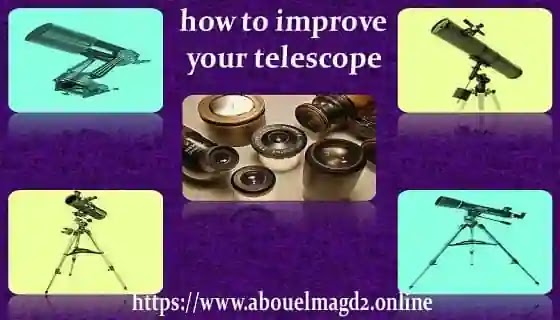The universe is simply infinite. And even the nearest planetary and star systems are at a tremendous distance.
We just can’t get there for now. But then, at least we want to watch it. See it.
There are some people who complain “with a small telescope they can’t see much!”. And you, too, may agree.
And you know what? They are right! They will never be able to see more than what they try for.
 |
| How to improve your telescope | Simple yet effective methods |
These so-called beginner astronomers get discouraged because they don’t get the results they expected.
Observing the sky is not like spying on your neighbors with binoculars. It’s not that quick!
Be aware that a good sky watcher is also very patient and able to stare through lenses for hours on end.
To be exceptionally clear, further developing telescope execution isn’t just with regards to tuning the extension. Obviously, it’s essential for it. In any case, you likewise need to teach yourself and your eyes.
So in this article, today, you will become familiar with some adjustable hacks. I have viewed this to be the best. These are some simple tips to further develop a DIY telescope that works.
So the following are a couple of things that can assist with working on yourself as well as your telescope too. So you can see more and better:
1. Look for a clear sky
There is no substitute for clear skies. In fact, it can indirectly add an extra inch to the hole.
Look up in the sky in the daytime for clues. Are there clouds? When the sun is over the head, block it with your hand and see if it’s clear blue around it. At sunrise or sunset, make sure there are no clouds on the horizon.
2. Avoid Light Pollution
Pollution in no form is good for us. Also, with regards to stargazing, the riskiest one is light contamination.
We usually observe the sky at night time. The simple justification behind this is on the grounds that we need our environmental elements as dim as could really be expected. So you can expressly see the light coming from that charming minimal far-off object. In any case, in our cutting-edge society, there’s light contamination all over the place. So it’s never gonna be an ideal spot. So what you have to do is go to a dark place.
It should contain a minimum amount of artificial light (such as street lamps and the like). Disappearing from the city is best when you need to see faint/far-off objects.
3. New Moon is Good
Aim for longer hours of observations especially on the new moon. Try to have at least two sessions per week.
4. Let Your Eyes Adopt to Darkness
Understand your eyes. They are on habit to brightness. So it takes some time and training for your eyes to adapt to the dark. And your pupil to set up.
When you start observing in dark surroundings. Make sure you don’t see sources directly (like phones, or light bulbs, etc.). It will disturb the adaptation. Use a red flashlight if needed and still don’t directly look inside it. It may take up to half an hour for your eyes to be at their 100% ability.
5. Keep Staring at it!
You know what? There’s a secret! To actually notice the details. Simply continue to gaze at the item continually through the eyepiece. Also, as you keep on, the subtleties begin to open. It may take an hour to enjoy the full view. Off-course, the time varies with distance from the object. Moreover, you can enjoy a little sigh in the middle while gazing. However, simply do not disturb your eye (pupil) with bright objects.
6. Thermally Optimize the Scope
Almost certainly, when you put your telescope outside to begin observations, it will be much warmer than the air outside.
What then happens is, the scope radiates heat which can cause problems to view. So no matter how small your scope is, it’s better to allow it to collimate to the outside temperature.
For scopes up to 4 inches, it for the most part requires 20 minutes. Also, for scopes bigger than 4 inches, add 10 minutes extra for every extra inch.
Usually, reflector scope takes less time for the process than Refractor.
7. Stabilize Your Telescope Mount
Hold it strong! As you zoom in on the objects, the tiny vibrations your scope makes, are also zoomed in. It’s a big problem when you zoom high. You just won’t be able to see things at their best. They just won’t look clear! It’s usually a big problem with cheap, lightweight telescopes.
So what you have to do is to stabilize it. Suspend some heavyweight (like Rucksack, or water bottles, and so forth) to the stand. Hope you got the clue!
So get out there with your adorable scope. Follow all those tips I mentioned above. Get the experience you never got before. And let me know, how much you can see now and if there are any improvements? Just comment below for anything you needed!
